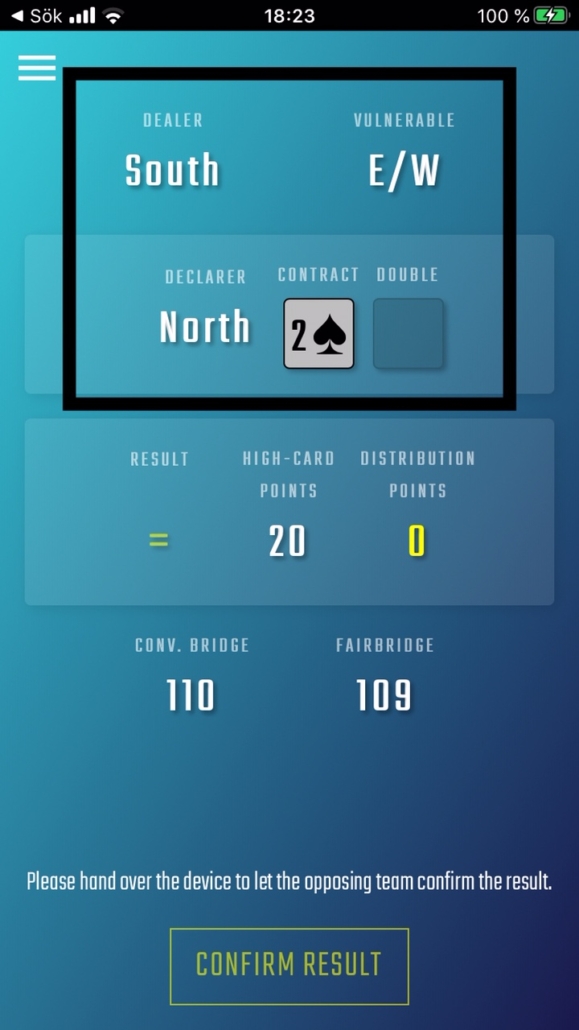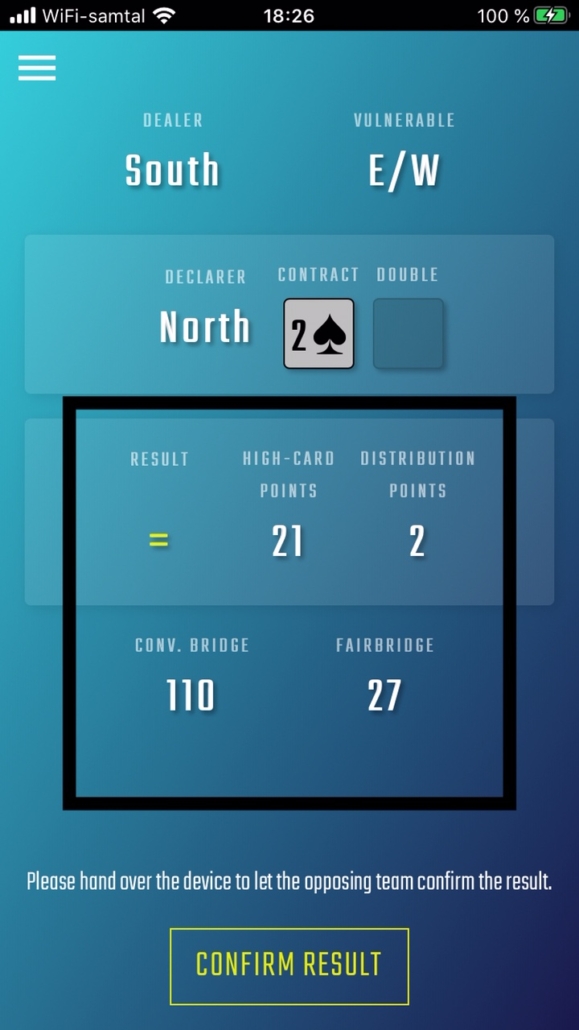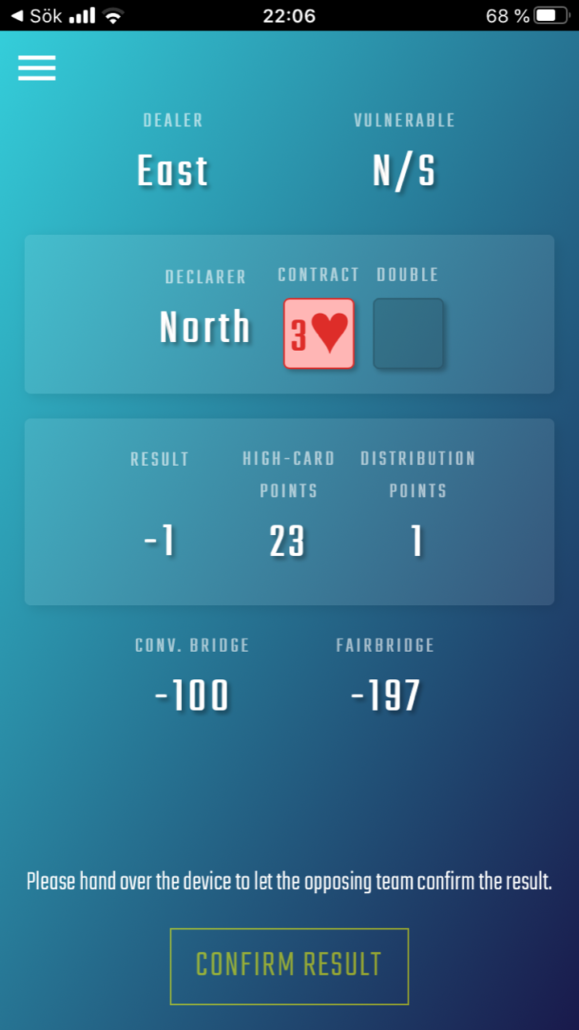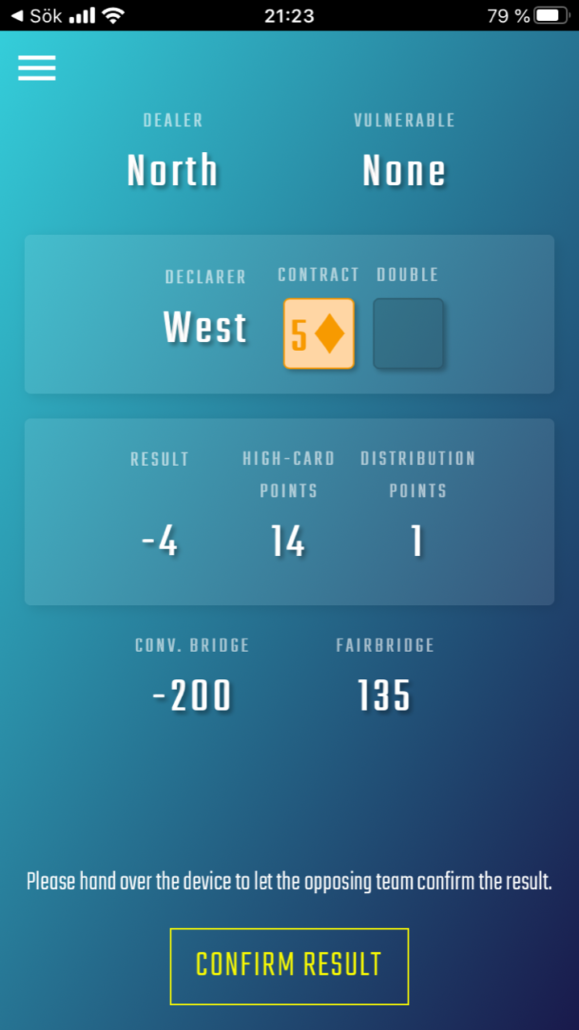More about the FAIRBridge scoring method
We are happy that you are interested in fully understanding how the FAIRBridge scoring system works. The very basics are the following:
- Both hands of the declaring side are given a total card point value (high-card points plus distribution points)
- Based on that value FAIRBridge determines an expected AVERAGE duplicate bridge outcome for the declaring side. For example, the expected AVERAGE outcome for making the contract 1NT with 22 high-card points is 50 duplicate bridge points.
- After playing the hand, the expected average outcome is deducted from the duplicate bridge score. So, if you exactly make 1NT with 22 high-card points, you receive 90-50=40 FAIRBridge points. If you go minus one (non-vulnerable) you receive -50-50=-100 FAIRBridge points.
- You can receive both positive and negative FAIRBridge scores. If your total is zero when the game is over, you have done exactly what is expected, given the cards you were dealt. You are on ”par”, for those playing golf. If your total is positive, you have played better than the average expected outcome, if it is negative, you have not.
Duplicate scoring
FAIRBridge will automatically compute the duplicate scores so you don’t need to know how to do the calculations, but in order to fully understand the FAIRBridge scoring method, you need to know duplicate bridge scoring. You can still use FAIRBridge if you are only used to rubber bridge, though. The game will still be scored automatically and there will be a winning side, but you will probably not understand the individual scores as well as you could. Learn more about contract bridge scoring here.
Before the hand is played
FAIRBridge automatically keeps track of dealer and vulnerability. After the bidding, enter the declarer and the contract to be played. Also enter if the contract was doubled or redoubled.
After the hand has been played
Enter the result (e.g. -2, = or +1) as well as the sum of high-card points and sum of distribution points. FAIRBridge automatically displays the duplicate bridge score and the FAIRBridge score.
Keeping score
The duplicate bridge score and the FAIRBridge score is shown for each side. Sometimes you will notice that they show different winners, as the FAIRBridge score has taken card quality into account.
How is the FAIRBridge score calculated?
Through analysis of tens of thousands of hands, we have determined an expected average duplicate bridge score for each combination of contract and Total Card Points (high-card points+distribution points). This is the score to reach to get zero FAIRBridge points. If you get a higher duplicate bridge score than the average, your FAIRBridge score will be positive. If you get a lower duplicate bridge score, your FAIRBridge score will be negative. See below for examples.
Game was made with 25+2=27 TCP, which is close to the expected result. You therefore get only 38 FAIRBridge points.
The average result when playing 3 hearts with 24 TCP is 97 duplicate bridge points. The FAIRBridge score is therefore -100-97=-197, way below the expected result.
East/West took the contract to prevent game for N/S. They are playing with only 15 TCP and the expected duplicate bridge score is negative. They receive 135 FAIRBridge points. Well done!
Ouch! North missed a slam with 34 TCP. The result is a FAIRBridge score of -420, which is really bad.
Important scoring considerations
The Game ”paradox”
With 25 high-card points you should bid game in NT and with 26 TCP you should bid game in a major. Should you therefore receive zero FAIRBridge points for making game in NT with 25 TCP or in a major with 26 TCP? The answer is no. The average result, over many thousand hands is lower than 400 (or 600 vulnerable), since you don’t make game every time. If you DO make game every time you bid 3NT or 4sp, you are not bidding aggressively enough. Therefore, you receive a positive FAIRBridge result if you do. It is very important to keep in mind that FAIRBridge works with averages.
Sometimes it IS unfair
You might have 28 TCP and still fail to make game and when you look at the cards it was in fact impossible. Since FAIRBridge only looks at TCP and thinks you should have made game, even though it was impossible, you will receive a very negative score. This is just the way it is, and it will even out in the long run.
Extreme FAIRBridge scores are reduced
With 36 TCP (vulnerable), your expected duplicate bridge score would be around 1400. Let’s say that you go one minus on the contract, so your score is -100. If we did nothing to change the FAIRBridge score it would be -100-1400=-1500. This would mean that the game is essentially over, since it is virtually impossible to dig yourselves out of a hole that big. We are therefore reducing extreme values, so that almost all FAIRBridge scores are between -400 and +400. The added benefit is that the small contracts have a larger relative impact on the final score than they would have otherwise, making every hand more interesting.







